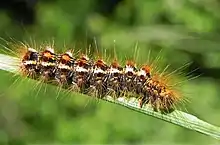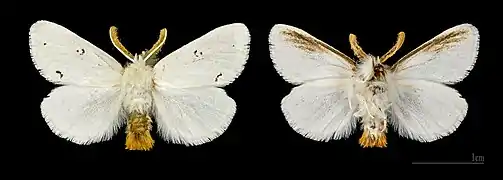Euproctis chrysorrhoea
La mariposa lagarta cola parda (Euproctis chrysorrhoea) es una polilla de la familia Erebidae. Se encuentra en Europa. En América del Norte solo se encuentra en la costa de Maine y Cape Cod donde está considerada una especie invasora que llegó a Estados Unidos en 1890 en plantas provenientes de Europa.[1]
| Mariposa lagarta cola parda | ||
|---|---|---|
.jpg.webp) Mariposa lagarta cola parda | ||
| Taxonomía | ||
| Reino: | Animalia | |
| Filo: | Arthropoda | |
| Clase: | Insecta | |
| Orden: | Lepidoptera | |
| Familia: | Erebidae | |
| Género: | Euproctis | |
| Especie: |
E. chrysorrhoea (Linnaeus, 1758) | |

Euproctis chrysorrhoea, larva
Plantas de las que se alimenta
- Acacia
- Acer - Arce
- Arbutus
- Amelanchier
- Arctium
- Betula - Abedul
- Carya
- Castanea - Castaño
- Chaenomeles speciosa - Membrillo de flor
- Crataegus
- Cydonia - Membrillo
- Fagus - Hayas
- Forsythia
- Fragaria - Frutilla
- Fraxinus - Fresno
- Geranium
- Gossypium
- Hippophae
- Juglans - Nuez
- Malus - Manzano
- Myrica
- Parthenocissus
- Plantago
- Populus - Álamo
- Prunus
- Pyrus - Pera
- Quercus - Roble
- Rheum - Ruibarbo
- Ribes
- Robinia
- Rosa - Rosa
- Rubus
- Rumex
- Salix - Sauce
- Sambucus
- Sorbus
- Spiraea
- Tilia
- Trifolium - Trébol
- Ulmus - Olmo
- Viburnum
- Vitis - Uva
- Weigela
- Wisteria
_Female.jpg.webp) ♀
♀ ♂
♂
Referencias
- Chinery, Michael Collins Guide to the Insects of Britain and Western Europe 1986 (Reprinted 1991)
- Skinner, Bernard Colour Identification Guide to Moths of the British Isles 1984
- Fernald, Charles H. & Kirkland, Archie H. (1903). "The brown-tail moth, Euproctis chrysorrhoea (L.). A report on the life history and habits of the imported brown-tail moth, together with a description of the remedies best suited for destroying it". Wright & Potter Printing Co., Boston.
- Jaenike, J. (1990) Host specialization in phytophagous insects. Annual Review of Ecology and Systematics, 21, 243-273.
- Forestry Compendium (2005) Euproctis chrysorrhoea L. (Lepidoptera: Lymantriidae) Datasheet. [Online] Wallingford: CAB International.
- Fernald,C. & Kirkland,A. (1903) The Brown-tail moth, Euproctis chrysorrhoea: a report on the life history and habits of the imported Brown-tail moth. Wright and Potter Printing, Boston.
- Saccuman, G. (1963) Contributo alla conoscenza della Euproctis chrysorrhoea L. Bolletino del Laboratorio di Entomologia Agraria "Filippo Silvestri", 21, 271-322.
- Torossian, C., Torossian, F., Roques, L. (1988) Le bombyx cul brun: Euproctis chrysorrhoea, (1) Cycle biologique-ecologie-nuisibilite. Bulletin de la Societe d'Histoire Naturelle de Toulouse 124, 127-174.
- Kelly, P.M., Speight, M.R. & Entwistle, P.F. (1989) Mass production and purification of Euproctis chrysorrhoea (L) Nuclear Polyhedrosis Virus. Journal of Virological Methods, 25, 93-99.
- Frago,E., Selfa,J., Pujade-Villar,J., Guara,M. & Bauce,E. (2009) Age and size thresholds for pupation and developmental polymorphism in the browntail moth, Euproctis chrysorrhoea (Lepidoptera: Lymantriidae), under conditions that either emulate diapause or prevent it. Journal of Insect Physiology, 55, 952-958.
- Dissescu,G. (1964) On a new method of the forecast of the Brown-Tail Moth. Zoologichesky Zhurnal, 43, 1795-1799.
- Schaefer,P.W. (1974) Population ecology of the browntail moth, Euproctis chrysorrhoea (Lepidoptera: Lymantriidae). PhD thesis. University of Maine, Orono.
- Zeitgamel, Y.S. (1974) Population dynamics of Euproctis chrysorrhoea in the Central-Chernozem State Reservation. Zoologichesky Zhurnal, 53, 292-296.
- Sterling,P.H. & Speight,M.R. (1989) Comparative mortalities of the Brown-tail moth, Euproctis chrysorrhoea (L) (Lepidoptera, Lymantriidae), in Southeast England. Botanical Journal of the Linnean Society, 101, 69-78.
- Arévalo-Durup, P. (1991) Le nid d'hiver d'Euproctis chrysorrhoea L. (Lepidoptera: Lymantriidae) comme estimateur de population en milieu forestier. Ph.D. Toulouse: Université Paul Sabatier.
- Elkinton, J.S., Preisser, E., Boettner, G. & Parry, D. (2008) Factors influencing larval survival of the invasive Browntail Moth (Lepidoptera: Lymantriidae) in relict North American populations. Environmental Entomology, 37, 1429-1437.
- Frago, E., Pujade-Villar, J., Guara, M., Selfa, J. (2011) Providing insights into browntail moth local outbreaks by combining life table data and semi-parametric statistics. Ecological Entomology 36, 188-199.
- Elkinton, J.S., Parry, D., Boettner, G.H. (2006) Implicating an introduced generalist parasitoid in the invasive browntail moth's enigmatic demise. Ecology 87, 2664-2672.
- Pantyukhov,G.A. (1962) The effect of positive temperatures upon different populations of the brown-tail moth Euproctis chrysorrhoea L. and the gipsy moth Lymantria dispar L.. (Lepidoptera, Orgyidae). Entomologicheskoe Obozrenie, 41, 274-284.
- Pantyukhov,G.A. (1964) The effect of negative temperatures on populations of the brown-tail moth Euproctis chrysorrhoea L. and the gipsy moth Lymantria dispar L. (Lepidoptera, Orgyidae). Review of applied entomology. Series A, 54, 434-436.
Enlaces externos
- Brown-tail at Markku Savela's Lepidoptera pages Archivado el 10 de agosto de 2010 en Wayback Machine.
- Brown-tail at moineaudeparis.com
Este artículo ha sido escrito por Wikipedia. El texto está disponible bajo la licencia Creative Commons - Atribución - CompartirIgual. Pueden aplicarse cláusulas adicionales a los archivos multimedia.